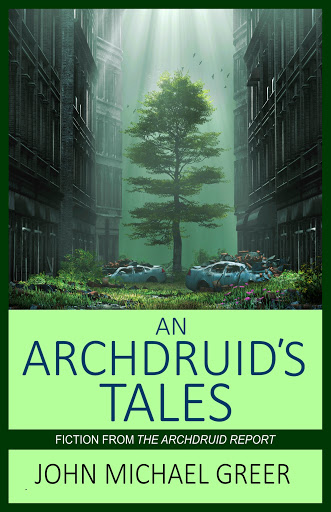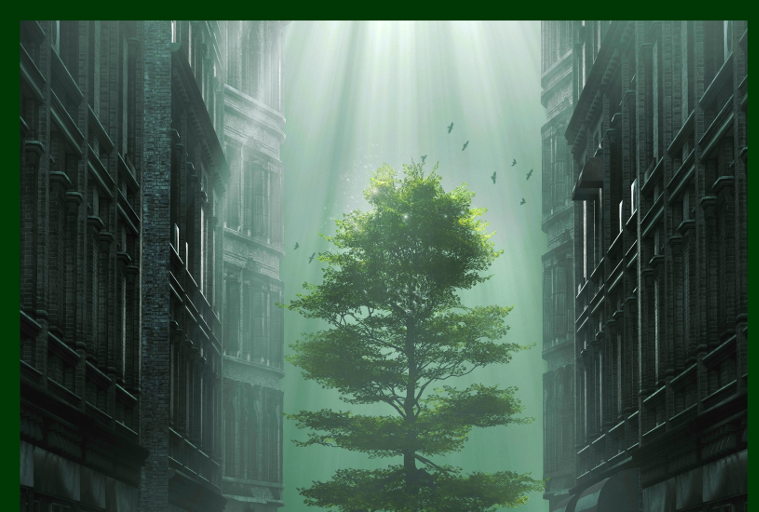 An Archdruid’s Tales: Fiction from The Archdruid Report
An Archdruid’s Tales: Fiction from The Archdruid Report
By John Michael Greer
Paperback, 5.5″ x 8.5″, 192 pp., $13.99.
eBook formats: ePub Edition, file size: 0.4 MB, $4.99; Amazon Kindle Edition, file size: 2.5 MB, $4.99.
Founders House Publishing, May 2017.
John Michael Greer is a longtime scholar of civilizational decline, and he’s noticed that when most people try to make sense of our current civilization’s inevitable fall, they succumb to an odd fallacy. A fair number of those who accept the impermanence of modern industrial society somehow seem to expect its demise to be abrupt and to conclude within their lifetimes, despite all the historical evidence showing civilizational decline to be gradual. To Greer, this expectation of sudden doom has an obvious emotional appeal, namely the fact that it absolves one from having to do something about humanity’s crisis. When you believe the world is just about to go up in one big, spectacular explosion, what’s the point in changing the way you live in an effort to reduce your burden on the planet? This same logic drives those who believe in a future of perpetual betterment: If you think everything is going to work out fine, there’s likewise no use in taking action.
In his anthology An Archdruid’s Tales, Greer seeks to use fiction, together with a few nonfiction forays into future scenarios, as a means of painting a more accurate picture of what lies ahead for industrial civilization. These pieces vary in their approaches. One of them, a series of linked fictional vignettes that began as weekly blog posts, uses a sort of “snapshot” effect to underscore the multigenerational time spans at play in the process of decline. Each of its parts is set 50 years further into the future than the one before it, the time lapses bringing slow changes into sharp focus. Another story that started as serials on the same blog, The Archdruid Report, uses the framework of a long journey to show how conditions can vary greatly from one community to the next at any given point in the fall of a civilization. There are even two brilliant fictional news stories aimed at satirizing various articles of faith about humanity’s future.
The collection of snapshot vignettes is titled “Winter’s Tales.” Its opening scene takes place on Christmas Eve 2050, in the home of a family joyously preparing for the evening’s festivities. Daily life in this future would seem dystopian to most present-day readers. The climate is inexorably heating up, disease mortality is soaring, basic necessities are prohibitively expensive by today’s standards, long-distance travel has become the privilege of the rich and widespread access to television and the Internet is a thing of the past. Yet this family is in good spirits because things used to be far worse, plus they’ve begun to stabilize of late (in keeping with the theme of an uneven, drawn-out descent). Food may be expensive, but at least there’s plenty of it to go around. Industries that involve recycling are booming, providing both parents with gainful employment for the foreseeable future. And inflation has come down from its crazy highs from before the last currency reform.
The remaining two vignettes capture pivotal moments in the history of the same family over the next century. The second one picks up in 2100, by which time the family’s town is a dust bowl in which water is so scarce that even hand washing is considered wasteful. America has inflated its currency into worthlessness and broken into several new countries. Today’s consumer culture is long gone, Christianity has mostly given way to a handful of nature-centered faiths, people have forgotten how to keep the few remaining machines running and previously discarded technologies like blacksmithing and the slide rule are being revived en masse.
The final chapter of this narrative takes place in 2150. The local climate has turned tropical and Antarctica has been settled and found to have sizeable gold deposits in its newly thawed ground. Christianity is dead, the English language isn’t far behind and there’s been a great blending of the races we know today. At one point we pass through a festival scene that captivatingly melds modern American culture (in the form of Western classical instruments) with sights out of a traditional village celebration (with scantily clad villagers of every age group gathering to feast and carouse after praying to their deities). As a second aside, this last vignette also contains the culmination of what for me is the most satisfying character arc, that of a reluctant child prodigy (a grandchild of the mother and father depicted in part one) turned village elder who’s charged with ensuring that the “Old Time” texts remain relevant in 2150.
“Adam’s Story” is the book’s second excursion into fiction. It’s a travel narrative that takes us through several disparate lands, some long abandoned, others clinging to life and still others vibrant and bustling. This panorama is clearly meant to put across the points that different locales descend the arc of decline at different rates, and that at any given juncture, each is likely to be faring a little differently depending on its own particular situation. The titular character wanders through ghost towns that were once popular tourist destinations and fishing ports, in the days when tourism was still alive and the oceans still plentifully stocked with fish. At the opposite extreme is the thriving harbor town where Adam and a companion he picks up along the way come to settle, which still has access to hydroelectricity, maritime trade, a diversified economy and a lively local folk culture.
Though all of the fictional pieces in An Archdruid’s Tales have their touching moments, for me the most poignant are in “Adam’s Story.” The friend Adam acquires during his journey is a Japanese woman named Haruko, who has fled her home country’s desperate conditions in search of a better life across the Pacific. At one point, the two come to a refugee checkpoint. Thinking fast, Adam claims that Haruko is his wife, and to prove it, he digs out his late wife’s wedding ring and places it on Haruko’s finger. Luckily, it fits. Asked by a still-suspicious guard why he had the ring stowed in his bag, he says it was to avoid being targeted by robbers. The ploy works. Afterward, Haruko asks Adam if he wants the ring back, he responds that he quite likes it where it is now, Haruko says she does as well—and we, for our part, are unable to suppress a charmed grin.
My second-favorite scene comes once Adam and Haruko have established themselves in their new community. Things are going swimmingly, but they sense that others are on eggshells around them, afraid to voice their suspicions about Haruko’s citizenship status. Then one day Haruko finds herself party to a Grange meeting discussing what to do about dwindling crop yields. It seems crops are failing at an accelerating rate due to the increasingly hot, wet climate, which is flooding fields. Haruko proposes they turn the fields into rice paddies, and while the suggestion is well taken, one man feels compelled to caution her against letting on where she learned about growing rice paddies; “I think we’re all gonna agree that you learned about rice in California or someplace, okay?” he counsels her. He and the others know they’re breaking the law by harboring a refugee, but it’s in their best interests to look the other way.
There is one somewhat oddball entry titled “How it Could Happen.” The reason why this one doesn’t quite fit the overall theme of the collection is that it deals with the toppling of an empire, as opposed to that of the larger civilization within which the empire exists. In his other writings, Greer has stressed that the collapse of an empire is an entirely different process from the waning of a civilization, one that transpires over months or years, not lifetimes. It’s sheer coincidence that right now we’re simultaneously facing the fall of the American empire and the ebbing of industrial civilization. But none of this makes “How it Could Happen” any less enjoyable. It’s a plausible, compelling account of how the United States could lose its empire status and eventually dissolve. Greer has gone on to expand it into an engrossing and well researched, if depressing, thriller novel titled Twilight’s Last Gleaming, which takes inspiration from the military techno-thrillers of Tom Clancy.
This book’s final part is a fascinating grab bag titled “Essays and Fictions.” As alluded to in its title, the entries in this section aren’t really fiction, in the sense of being made up of scenes following narrative arcs. One is a thought experiment inviting readers to imagine a hypothetical future situation, while another two are high-level synopses of future histories. The remaining two are cunning works of “faux-journalism” (to use Greer’s term): an “obituary” of Man, Conqueror of Nature, following his death from a petroleum overdose, and a satire on modern assumptions of human immutability titled “Atlantis Won’t Sink, Experts Agree.”
In the hands of a lesser author, this collection could have easily wound up being insufferably didactic, with the fictional characters blatantly spelling out the book’s themes in their dialogue and thoughts, and the nonfiction pieces making their points equally inartfully. But Greer, whose capacities for great storytelling and persuasive writing are as vast as his intellect, has regaled us with a set of moving tales that couldn’t feel more natural in their incorporation of ideology into their narratives, peppered with essays that sing just as beautifully.






